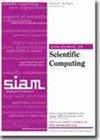用神经稀疏表示法求解玻尔兹曼方程
IF 2.6
2区 数学
Q1 MATHEMATICS, APPLIED
引用次数: 0
摘要
SIAM 科学计算期刊》,第 46 卷第 2 期,第 C186-C215 页,2024 年 4 月。 摘要我们考虑用神经稀疏表示法求解 BGK 和二次碰撞模型的玻尔兹曼方程,提出了一种基于网络的解析方法,它能以极高的效率逼近分布函数。确切地说,在时间和物理空间中采用了全连接神经网络,以避免空间和时间的离散化。在 BGK 和二次碰撞模型的微观速度中采用了不同的低秩表示,从而显著降低了自由度。我们使用典型多面体分解逼近 BGK 模型中的离散速度分布。对于二次碰撞模型,我们在 BGK 解法的基础上建立了一个数据驱动的、基于 SVD 的线性基础。所有这些都将大大提高网络在求解玻尔兹曼方程时的效率。此外,还提出了专门设计的自适应权重损失函数,将策略作为多尺度输入,并应用麦克斯韦分裂进一步提高逼近效率,加快学习过程。一些数值实验,包括一维波和 Sod 管问题以及二维波问题,证明了这些神经稀疏表示方法的有效性。本文章由计算机程序翻译,如有差异,请以英文原文为准。
Solving the Boltzmann Equation with a Neural Sparse Representation
SIAM Journal on Scientific Computing, Volume 46, Issue 2, Page C186-C215, April 2024.
Abstract. We consider the neural sparse representation to solve the Boltzmann equation with BGK and quadratic collision models, where a network-based ansatz that can approximate the distribution function with extremely high efficiency is proposed. Precisely, fully connected neural networks are employed in the time and physical space so as to avoid the discretization in space and time. Different low-rank representations are utilized in the microscopic velocity for the BGK and quadratic collision models, resulting in a significant reduction in the degree of freedom. We approximate the discrete velocity distribution in the BGK model using the canonical polyadic decomposition. For the quadratic collision model, a data-driven, SVD-based linear basis is built based on the BGK solution. All of these will significantly improve the efficiency of the network when solving the Boltzmann equation. Moreover, the specially designed adaptive-weight loss function is proposed with the strategies as multiscale input and Maxwellian splitting applied to further enhance the approximation efficiency and speed up the learning process. Several numerical experiments, including 1D wave and Sod tube problems and a 2D wave problem, demonstrate the effectiveness of these neural sparse representation methods.
Abstract. We consider the neural sparse representation to solve the Boltzmann equation with BGK and quadratic collision models, where a network-based ansatz that can approximate the distribution function with extremely high efficiency is proposed. Precisely, fully connected neural networks are employed in the time and physical space so as to avoid the discretization in space and time. Different low-rank representations are utilized in the microscopic velocity for the BGK and quadratic collision models, resulting in a significant reduction in the degree of freedom. We approximate the discrete velocity distribution in the BGK model using the canonical polyadic decomposition. For the quadratic collision model, a data-driven, SVD-based linear basis is built based on the BGK solution. All of these will significantly improve the efficiency of the network when solving the Boltzmann equation. Moreover, the specially designed adaptive-weight loss function is proposed with the strategies as multiscale input and Maxwellian splitting applied to further enhance the approximation efficiency and speed up the learning process. Several numerical experiments, including 1D wave and Sod tube problems and a 2D wave problem, demonstrate the effectiveness of these neural sparse representation methods.
求助全文
通过发布文献求助,成功后即可免费获取论文全文。
去求助
来源期刊
CiteScore
5.50
自引率
3.20%
发文量
209
审稿时长
1 months
期刊介绍:
The purpose of SIAM Journal on Scientific Computing (SISC) is to advance computational methods for solving scientific and engineering problems.
SISC papers are classified into three categories:
1. Methods and Algorithms for Scientific Computing: Papers in this category may include theoretical analysis, provided that the relevance to applications in science and engineering is demonstrated. They should contain meaningful computational results and theoretical results or strong heuristics supporting the performance of new algorithms.
2. Computational Methods in Science and Engineering: Papers in this section will typically describe novel methodologies for solving a specific problem in computational science or engineering. They should contain enough information about the application to orient other computational scientists but should omit details of interest mainly to the applications specialist.
3. Software and High-Performance Computing: Papers in this category should concern the novel design and development of computational methods and high-quality software, parallel algorithms, high-performance computing issues, new architectures, data analysis, or visualization. The primary focus should be on computational methods that have potentially large impact for an important class of scientific or engineering problems.

 求助内容:
求助内容: 应助结果提醒方式:
应助结果提醒方式:


